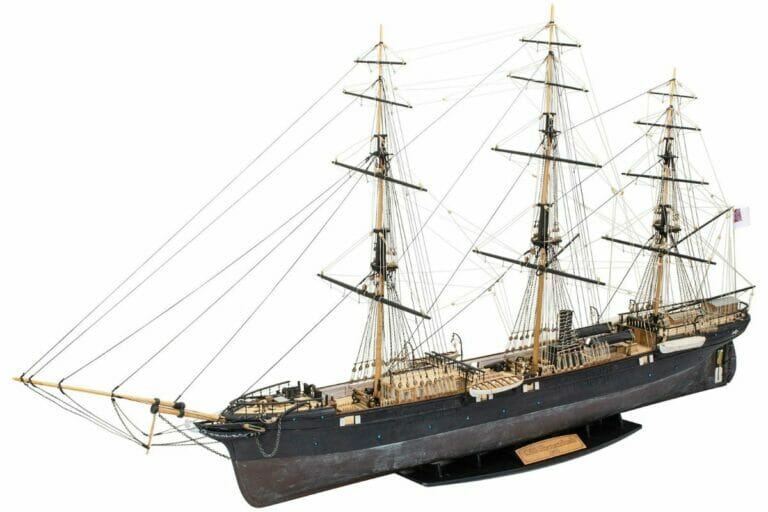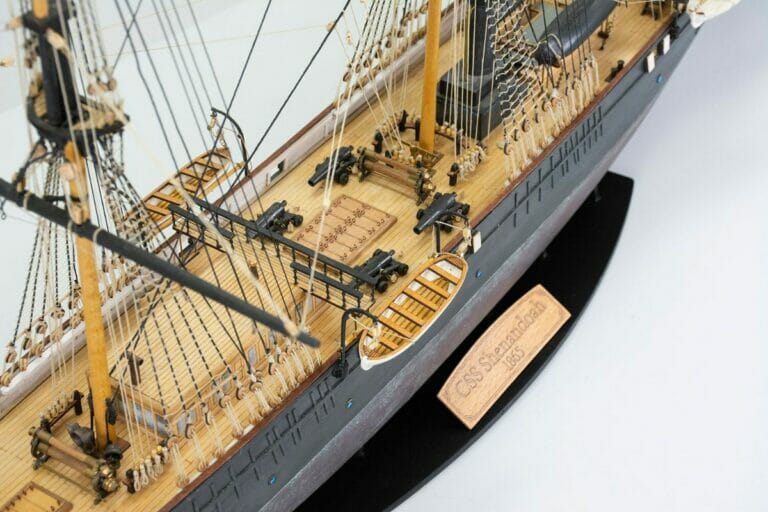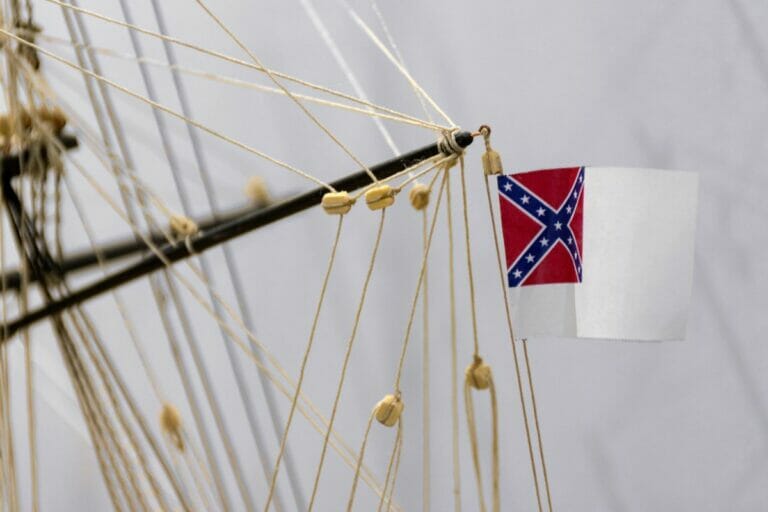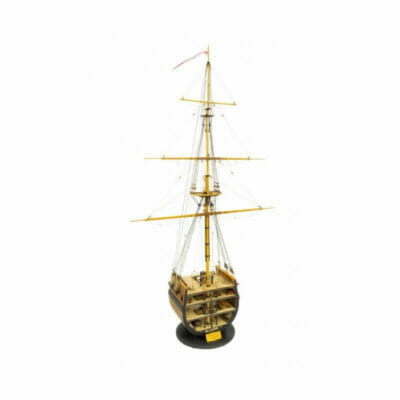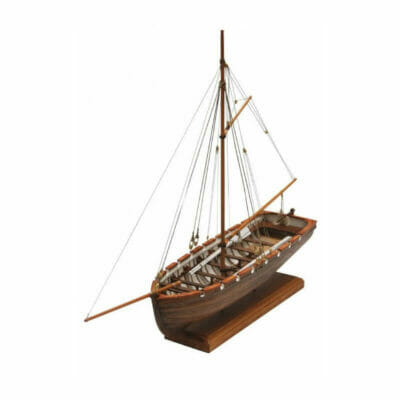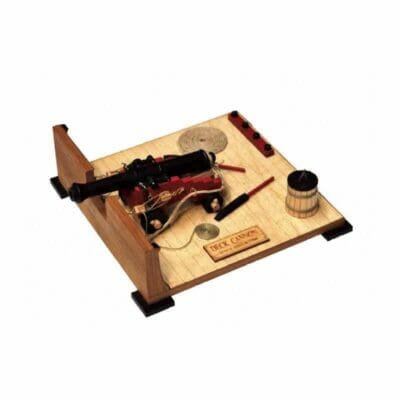CSS Shenandoah 1864
$398 Original price was: $398.$312.47Current price is: $312.47.
- Fast Shipping
- Safe & secure
- Worldwide delivery
| Skill Level | 5 |
|---|---|
| Scale | 1 to 84 |
| Length | 42.5" (1080mm) |
| Height | 22.4" (570mm) |
| Manufacturer | Modellers Shipyard |
| SKU | MS1016 |
CSS Shenandoah Model Ship Kit – Modellers Shipyard (KTMS1016)
The kit of the iconic ship CSS Shenandoah is now available.
The CSS Shenandoah 1864 model ship kit is manufactured by Modellers Shipyard. Modellers Shipyard offer historically accurate Wooden Model Ship Kits and Wooden Model Boat kits which are faithful interpretations of the original vessels.
All Modellers Shipyard kits come with highly detailed English building instructions with color photos showing every stage of the kit’s build. The kit can be displayed as Shenandoah or Sea King as both name plates are included in the kit.
As with all new release model ship kits from Modellers Shipyard the bulkheads have laser scored fairing lines that ensure the fairing of the bulkheads is easy, accurate and symmetrical – this feature is unique to Modellers Shipyard designed model ship kits.
View the instructions for the CSS Shenandoah
The kit’s details are: Scale: 1:84, Length: 1080mm, Width: 260mm, Height: 570mm
History of the CSS Shenandoah 1864
CSS Shenandoah, formerly Sea King, was an iron-framed, teak-planked, full rigged ship, with auxiliary steam power, captained by Confederate States Navy Commander James Waddell, a North Carolinian with twenty years of prior service in the United States Navy.
During 12½ months of 1864–1865 the ship undertook commerce raiding resulting in the capture and sinking or bonding of thirty-eight Union merchant vessels, mostly New Bedford whaleships. This ship is notable for firing the last shot of the American Civil War, at a whaler in waters off the Aleutian Islands.
The Sea King was built on the River Clyde, Scotland. Designed as a British commercial transport vessel for the East Asia tea trade and troop transport, her maiden voyage was transporting British troops to New Zealand. The Confederate Government purchased her in September 1864 for use as an armed cruiser to capture and destroy Union merchant ships.
On October 8, she sailed from London ostensibly for Bombay, India, on a trading voyage. She rendezvoused at Funchal, Madeira, with the steamer Laurel, bearing officers and the nucleus of a crew for Sea King, together with naval guns, ammunition, and stores. Commanding officer Lieutenant James Iredell Waddell supervised her conversion to a ship-of-war in nearby waters. Waddell was barely able, however, to bring his crew to half strength even with additional volunteers from Sea King and Laurel.
The new cruiser was commissioned on October 19 and her name changed to Shenandoah. The ship, commanded by Captain Waddell, then sailed around the Cape of Good Hope of Africa to Australia. While at Melbourne, Victoria, in January 1865, Waddell obtained additional men and supplies.
In accord with operation concepts originated in the Confederate Navy Department and developed by its agents in Europe, Shenandoah was assigned to “seek out and utterly destroy” commerce in areas as yet undisturbed (i.e., attack Union ships), and thereafter her course lay in pursuit of merchantmen on the Cape of Good Hope–Australia route and of the Pacific whaling fleet.
En route to the Cape she picked up six prizes. Five of these were put to the torch or scuttled, after Captain Waddell had safely rescued crew and passengers; the other was bonded and employed for transport of prisoners to Bahia, Brazil.
CSS Shenandoah Visits Australia
Still short-handed, though her crew had been increased by voluntary enlistments from prizes, Shenandoah arrived at Melbourne, Victoria, on January 25, 1865, where she filled her complement and her storerooms.
She also took on 40 crew members who were stowaways from Melbourne. However, they were not enlisted until the ship was outside the legal limits of Australian waters. The Shipping Articles show that all these 40 crew members enlisted on the day of her departure from Melbourne, February 18, 1865. Nineteen of her crew deserted at Melbourne, some of whom gave statements of their service to the United States Consul there. An 1871 hearing at the International Court in Geneva awarded damages of £820,000 against Britain to the US government for use of the port facilities at Williamstown by the CSS Shenandoah.
Shenandoah took only one prize in the Indian Ocean, but hunting became more profitable after refitting in Melbourne. Enroute to the North Pacific whaling grounds, on April 3–4, Waddell burned four whalers in the Caroline Islands. After a 3-week cruise to the ice and fog of the Sea of Okhotsk yielded only a single prize, due to a warning which had preceded him, Waddell headed north past the Aleutian Islands into the Bering Sea and the Arctic Ocean. Shenandoah then proceeded to capture 11 more prizes.
CSS Shenandoah Surrenders
On June 27, 1865, he learned, from a prize Susan & Abigail, of General Robert E. Lee’s surrender when her captain produced a San Francisco newspaper reporting the flight from Richmond, Virginia, of the Confederate Government 10 weeks previously. The same paper contained Confederate President Jefferson Davis’s proclamation, after Lee’s surrender, that the “war would be carried on with re-newed vigor.” He then proceeded to capture 10 more whalers in the space of 7 hours in the waters just below the Arctic Circle. It was not until August 2 that Shenandoah learned of the final Confederate collapse when she encountered the British barque Barracouta. Among the devastating news was surrender of General Joseph E. Johnston and his various armies (April 26), Kirby Smith’s, (May 26) and Magruder’s armies and, crucially, the capture of Mr. Davis and a part of his cabinet. Captain Waddell then disarmed the ship and proceeded back to surrender at Liverpool.
Barracouta had come from San Francisco; Waddell was heading to the city to attack it, believing it weakly defended. Immediately Shenandoah underwent physical alteration. She was dismantled as a man-of-war; her battery was dismounted and struck below, and her hull repainted to resemble an ordinary merchant vessel.
Regardless of Davis’s proclamation and knowing the unreliability of newspapers at the time, Captain Waddell and the crew knew returning to a US port would mean facing a Union court with a Northern perspective of the war. They correctly predicted the risk of being tried in a US court and hanged as pirates. This later showed to be accurate. Commerce raiders were not included in the reconciliation and amnesty that Confederate soldiers were given. Captain Raphael Semmes of CSS Alabama escaped charges of piracy by surrendering May 1, 1865 as a Ground General under Joseph E. Johnston. Semmes’s former sailors surrendered as artillerymen.
The CSS Shenandoah was therefore surrendered by Captain Waddell to the Captain of HMS Donegal on November 6, 1865, after traveling 9,000 miles (14,500 km) to Liverpool to do so. This marked the last surrender of the American Civil War. She was then turned over to the United States government. The United States Naval War Records published in 1894 as The Official Records of the Union and Confederate Navies in the War of Rebellion state: “November 5 – Arrived in the Mersey, off Liverpool, and on Monday, the 6th, surrendered the Shenandoah to the British nation, by letter to Lord John Russell, premier of Great Britain. (signed) JAMES I WADDELL.”
After the surrender of Shenandoah to the British, the British had to decide what to do with the Confederate crew, knowing the consequences of piracy charges.
After a full investigation by law officers of the crown, it was decided that the officers and crew had done nothing against the rules of war or the laws of nations to justify being held as prisoners, so they were unconditionally released. But the authorities of the United States considered them pirates and would have treated them as such if they had fallen into their hands.
S.S. Lee, Orris M. Brown, John T. Mason and W. C. Whittle sometime in December 1865 sailed from Liverpool to Buenos Aires, via Bahia, Rio de Janeiro and Montevideo. After prospecting for a while, they went to Rosario, upon Paraná River, and near there bought a small place and began farming.
As the animosity of the United States Government began to soften towards them, Brown and Mason returned home, Lee and Whittle returned sometime later.
On returning home, Mason took a law course at the University of Virginia, graduated, and was successful at his profession. He settled in Baltimore, and married Miss Helen Jackson, of New York, daughter of the late Lieutenant Alonzo Jackson of the U. S. Navy.
Shenandoah remained at sea for 12 months and 17 days, traversed 58,000 miles (carrying the Confederate flag around the globe for the only time) and sank or captured 38 ships, mostly whalers. Waddell took close to one thousand prisoners, without a single war casualty among his crew: two men died of disease. The reason the vessel did not have any war casualties was because it was never involved in a battle against any Union Naval vessel, as was the CSS Alabama, but instead took United States merchant vessels.
In 1866 the US, having taken possession of Shenandoah, sold her to the first Sultan of Zanzibar, who renamed her after himself (El Majidi). On April 15, 1872 a hurricane hit Zanzibar. Shenandoah (El Majidi) was one of 6 ships owned by Seyed Burgash which were blown on shore and seriously damaged.
Shenandoah’s battle ensign has been in the Museum of the Confederacy’s collection since 1907 and is currently on display. Lieutenant Dabney Scales CSN, gave the flag to a cousin, Eliza Hull Maury, for safekeeping. Eliza Hull Maury was a daughter of Richard Launcelot Maury who was the eldest son of Commodore Matthew Fontaine Maury. Colonel Richard Launcelot Maury CSA, Eliza’s brother, brought the flag from England in 1873, and donated it to the Museum in 1907. The flag itself measures 88″ x 136.”
| Skill Level | 5 |
|---|---|
| Scale | 1 to 84 |
| Length | 42.5" (1080mm) |
| Height | 22.4" (570mm) |
| Manufacturer | Modellers Shipyard |
| SKU | MS1016 |







